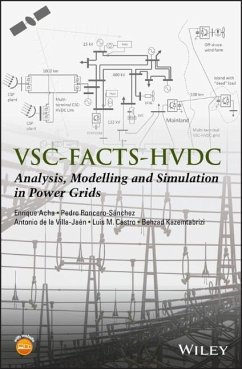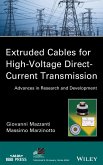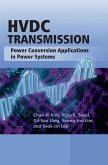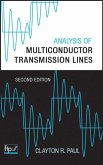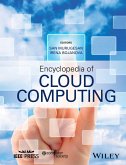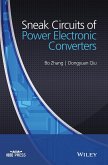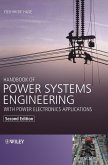Enrique E. Acha, Rodrigo García-Valle, Luigi Vanfretti, Antonio de la Villa Jaén, Behzad Kazemtabrizi, Roncero
Vsc-Facts-Hvdc
Analysis, Modelling and Simulation in Power Grids
Enrique E. Acha, Rodrigo García-Valle, Luigi Vanfretti, Antonio de la Villa Jaén, Behzad Kazemtabrizi, Roncero
Vsc-Facts-Hvdc
Analysis, Modelling and Simulation in Power Grids
- Gebundenes Buch
- Merkliste
- Auf die Merkliste
- Bewerten Bewerten
- Teilen
- Produkt teilen
- Produkterinnerung
- Produkterinnerung
VSC-FACTS, HVDC and PMU: Analysis, Modelling and Simulation in Power Grids provides comprehensive coverage of VSC-FACTS and VSC-HVDC systems within the context of high-voltage Smart Grids modelling and simulation. Readers are presented with an examination of the advanced computer modelling of the VSC-FACTS and VSC-HVDC systems for steady-state, optimal solutions, state estimation and transient stability analyses, including numerous case studies and practical examples.
Key features: Wide-ranging treatment of the VSC achieved by assessing basic operating principles, topology structures,…mehr
Andere Kunden interessierten sich auch für
![Extruded Cables for HVDC Trans Extruded Cables for HVDC Trans]() Giovanni MazzantiExtruded Cables for HVDC Trans142,99 €
Giovanni MazzantiExtruded Cables for HVDC Trans142,99 €![Hvdc Transmission Hvdc Transmission]() Chan-Ki KimHvdc Transmission180,99 €
Chan-Ki KimHvdc Transmission180,99 €![Analysis of Multiconductor Transmission Lines Analysis of Multiconductor Transmission Lines]() Clayton R. PaulAnalysis of Multiconductor Transmission Lines239,99 €
Clayton R. PaulAnalysis of Multiconductor Transmission Lines239,99 €![Cloud Management and Security Cloud Management and Security]() Imad M. AbbadiCloud Management and Security122,99 €
Imad M. AbbadiCloud Management and Security122,99 €![Encyclopedia of Cloud Computing Encyclopedia of Cloud Computing]() Encyclopedia of Cloud Computing161,99 €
Encyclopedia of Cloud Computing161,99 €![Sneak Circuits of Power Electronic Converters Sneak Circuits of Power Electronic Converters]() Bo ZhangSneak Circuits of Power Electronic Converters183,99 €
Bo ZhangSneak Circuits of Power Electronic Converters183,99 €![Handbook of Power Systems Engineering with Power Electronics Applications Handbook of Power Systems Engineering with Power Electronics Applications]() Yoshihide HaseHandbook of Power Systems Engineering with Power Electronics Applications183,99 €
Yoshihide HaseHandbook of Power Systems Engineering with Power Electronics Applications183,99 €-
-
-
VSC-FACTS, HVDC and PMU: Analysis, Modelling and Simulation in Power Grids provides comprehensive coverage of VSC-FACTS and VSC-HVDC systems within the context of high-voltage Smart Grids modelling and simulation. Readers are presented with an examination of the advanced computer modelling of the VSC-FACTS and VSC-HVDC systems for steady-state, optimal solutions, state estimation and transient stability analyses, including numerous case studies and practical examples.
Key features:
Wide-ranging treatment of the VSC achieved by assessing basic operating principles, topology structures, control algorithms and utility-level applications.
Details advanced models of VSC-FACTS and VSC-HVDC equipment, suitable for a wide range of power network-wide studies, such as power flows, optimal power flows, state estimation and dynamic simulations.
Contains numerous case studies and practical examples, including cases of multi-terminal VSC-HVDC systems.
MATLAB software and Power System Computer Aided Design (PSCAD) scripts are provided to enable the reader to gain hands-on experience.
Detailed coverage of electromagnetic transient studies of VSC-FACTS and VSC-HVDC systems using the de-facto industry standard PSCAD(TM)/EMTDC(TM) simulation package.
An essential guide for utility engineers, academics, and research students as well as industry managers, engineers in equipment design and manufacturing, and consultants.
Hinweis: Dieser Artikel kann nur an eine deutsche Lieferadresse ausgeliefert werden.
Key features:
Wide-ranging treatment of the VSC achieved by assessing basic operating principles, topology structures, control algorithms and utility-level applications.
Details advanced models of VSC-FACTS and VSC-HVDC equipment, suitable for a wide range of power network-wide studies, such as power flows, optimal power flows, state estimation and dynamic simulations.
Contains numerous case studies and practical examples, including cases of multi-terminal VSC-HVDC systems.
MATLAB software and Power System Computer Aided Design (PSCAD) scripts are provided to enable the reader to gain hands-on experience.
Detailed coverage of electromagnetic transient studies of VSC-FACTS and VSC-HVDC systems using the de-facto industry standard PSCAD(TM)/EMTDC(TM) simulation package.
An essential guide for utility engineers, academics, and research students as well as industry managers, engineers in equipment design and manufacturing, and consultants.
Hinweis: Dieser Artikel kann nur an eine deutsche Lieferadresse ausgeliefert werden.
Produktdetails
- Produktdetails
- Verlag: Wiley & Sons
- 1. Auflage
- Seitenzahl: 416
- Erscheinungstermin: 12. August 2019
- Englisch
- Abmessung: 251mm x 172mm x 30mm
- Gewicht: 878g
- ISBN-13: 9781119973980
- ISBN-10: 1119973988
- Artikelnr.: 35061012
- Herstellerkennzeichnung
- Libri GmbH
- Europaallee 1
- 36244 Bad Hersfeld
- gpsr@libri.de
- Verlag: Wiley & Sons
- 1. Auflage
- Seitenzahl: 416
- Erscheinungstermin: 12. August 2019
- Englisch
- Abmessung: 251mm x 172mm x 30mm
- Gewicht: 878g
- ISBN-13: 9781119973980
- ISBN-10: 1119973988
- Artikelnr.: 35061012
- Herstellerkennzeichnung
- Libri GmbH
- Europaallee 1
- 36244 Bad Hersfeld
- gpsr@libri.de
Professor Enrique Acha, Laboratory of Electrical Energy Engineering, Tampere University of Technology, Finland Dr Pedro Roncero-ánchez, Department of Electronics, Electrical Engineering and Control Systems, University of Castilla-La Mancha, Spain Dr Antonio de la Villa-Jaén, Department of Electrical Engineering, University of Seville, Spain Dr Luis M. Castro, Faculty of Engineering, National University of Mexico (UNAM), Mexico City, Mexico Dr Behzad Kazemtabrizi, School of Engineering, Durham University, UK
Preface xiii
About the Book xvii
Acknowledgements xxi
About the Companion Website xxiii
1 Flexible Electrical Energy Systems 1
1.1 Introduction 1
1.2 Classification of Flexible Transmission System Equipment 5
1.2.1 SVC 6
1.2.2 STATCOM 7
1.2.3 SSSC 9
1.2.4 Compound VSC Equipment for AC Applications 10
1.2.5 CSC-HVDC Links 12
1.2.6 VSC-HVDC 13
1.3 Flexible Systems Vs Conventional Systems 15
1.3.1 Transmission 16
1.3.1.1 HVAC Vs HVDC Power Transmission for Increased Power Throughputs 16
1.3.1.2 VAR Compensation 19
1.3.1.3 Frequency Compensation 24
1.3.2 Generation 27
1.3.2.1 Wind Power Generation 28
1.3.2.2 Solar Power Generation 30
1.3.3 Distribution 33
1.3.3.1 Load Compensation 35
1.3.3.2 Dynamic Voltage Support 35
1.3.3.3 Flexible Reconfigurations 36
1.3.3.4 AC-DC Distribution Systems 37
1.3.3.5 DC Power Grids with Multiple Voltage Levels 40
1.3.3.6 Smart Grids 40
1.4 Phasor Measurement Units 43
1.5 Future Developments and Challenges 46
1.5.1 Generation 46
1.5.2 Transmission 47
1.5.3 Distribution 48
References 49
2 Power Electronics for VSC-Based Bridges 53
2.1 Introduction 53
2.2 Power Semiconductor Switches 53
2.2.1 The Diode 55
2.2.2 The Thyristor 56
2.2.3 The Bipolar Junction Transistor 57
2.2.4 The Metal-Oxide-Semiconductor Field-Effect Transistor 59
2.2.5 The Insulated-Gate Bipolar Transistor 59
2.2.6 The Gate Turn-Off Thyristor 59
2.2.7 The MOS-Controlled Thyristor 60
2.2.8 Considerations for the Switch Selection Process 61
2.3 Voltage Source Converters 61
2.3.1 Basic Concepts of PulseWidth Modulated-Output Schemes and Half-Bridge
VSC 62
2.3.2 Single-Phase Full-Bridge VSC 66
2.3.2.1 PWM with Bipolar Switching 67
2.3.2.2 PWM with Unipolar Switching 69
2.3.2.3 Square-Wave Mode 69
2.3.2.4 Phase-Shift Control Operation 69
2.3.3 Three-Phase VSC 72
2.3.4 Three-Phase Multilevel VSC 74
2.3.4.1 The Multilevel NPC VSC 76
2.3.4.2 The Multilevel FC VSC 80
2.3.4.3 The Cascaded H-Bridge VSC 81
2.3.4.4 PWM Techniques for Multilevel VSCs 85
2.3.4.5 An Alternative Multilevel Converter Topology 85
2.4 HVDC Systems Based on VSC 88
2.5 Conclusions 94
References 95
3 Power Flows 99
3.1 Introduction 99
3.2 Power Network Modelling 100
3.2.1 Transmission Lines Modelling 100
3.2.2 Conventional Transformers Modelling 100
3.2.3 LTC Transformers Modelling 101
3.2.4 Phase-Shifting Transformers Modelling 101
3.2.5 Compound Transformers Modelling 102
3.2.6 Series and Shunt Compensation Modelling 102
3.2.7 Load Modelling 102
3.2.8 Network Nodal Admittance 102
3.3 Peculiarities of the Power Flow Formulation 103
3.4 The Nodal Power Flow Equations 105
3.5 The Newton-Raphson Method in Rectangular Coordinates 106
3.5.1 The Linearized Equations 107
3.5.2 Convergence Characteristics of the Newton-Raphson Method 108
3.5.3 Initialization of Newton-Raphson Power Flow Solutions 109
3.5.4 Incorporation of PMU Information in Newton-Raphson Power Flow
Solutions 111
3.6 The Voltage Source Converter Model 112
3.6.1 VSC Nodal Admittance Matrix Representation 113
3.6.2 Full VSC Station Model 115
3.6.3 VSC Nodal Power Equations 117
3.6.4 VSC Linearized System of Equations 117
3.6.5 Non-Regulated Power Flow Solutions 119
3.6.6 Practical Implementations 120
3.6.6.1 Control Strategy 120
3.6.6.2 Initial Parameters and Limits 120
3.6.7 VSC Numerical Examples 121
3.7 The STATCOM Model 125
3.7.1 STATCOM Numerical Examples 127
3.8 VSC-HVDC Systems Modelling 129
3.8.1 VSC-HVDC Nodal Power Equations 131
3.8.2 VSC-HVDC Linearized Equations 133
3.8.3 Back-to-Back VSC-HVDC Systems Modelling 135
3.8.4 VSC-HVDC Numerical Examples 135
3.9 Three-Terminal VSC-HVDC System Model 139
3.9.1 VSC Types 142
3.9.2 Power Mismatches 142
3.9.3 Linearized System of Equations 143
3.10 Multi-Terminal VSC-HVDC System Model 146
3.10.1 Multi-Terminal VSC-HVDC System with Common DC Bus Model 147
3.10.2 Unified Solutions of AC-DC Networks 148
3.10.3 Unified vs Quasi-Unified Power Flow Solutions 148
3.10.4 Test Case 9 150
3.11 Conclusions 153
References 153
3.A Appendix 154
3.B Appendix 156
4 Optimal Power Flows 159
4.1 Introduction 159
4.2 Power Flows in Polar Coordinates 160
4.3 Optimal Power Flow Formulation 161
4.4 The Lagrangian Methods 162
4.4.1 Necessary Optimality Conditions (Karush-Kuhn-Tucker Conditions) 163
4.5 AC OPF Formulation 164
4.5.1 Objective Function 165
4.5.2 Linearized System of Equations 165
4.5.3 Augmented Lagrangian Function 167
4.5.4 Selecting the OPF Solution Algorithm 168
4.5.5 Control Enforcement in the OPF Algorithm 168
4.5.6 Handling Limits of State Variables 169
4.5.7 Handling Limits of Functions 169
4.5.8 A Simple Network Model 170
4.5.8.1 Step One - Identifying State and Control Variables 170
4.5.8.2 Step Two - Identifying Constraints 170
4.5.8.3 StepThree - Forming the Lagrangian Function 171
4.5.8.4 Step Four - Linearized System of Equations 172
4.5.8.5 Step Five - Implementation of the Augmented Lagrangian 172
4.5.9 Recent Extensions in the OPF Problem 173
4.5.10 Test Case: IEEE 30-Bus System 173
4.5.10.1 Test System 173
4.5.10.2 Problem Formulation 173
4.5.10.3 OPF Test Cases 174
4.5.10.4 Benchmark Test Case (With No Voltage Control) 175
4.5.10.5 Test Case with Voltage Control Using Variable Transformers Taps
(Case I) 176
4.5.10.6 Test Case with Nodal Voltage Regulation (Case II) 176
4.5.10.7 Test Case with Nodal Voltage Regulation (Case III) 177
4.5.10.8 A Summary of Results 177
4.6 Generalization of the OPF Formulation for AC-DC Networks 179
4.7 Inclusion of the VSC Model in OPF 181
4.7.1 VSC Power Balance Equations 181
4.7.2 VSC Control Considerations 183
4.7.3 VSC Linearized System of Equations 184
4.8 The Point-to-Point and Back-to-Back VSC-HVDC Links Models in OPF 184
4.8.1 VSC-HVDC Link Power Balance Formulation 185
4.8.2 VSC-HVDC Link Control 187
4.8.3 VSC-HVDC Full Set of Equality Constraints 188
4.8.4 Linearized System of Equations 189
4.9 Multi-Terminal VSC-HVDC Systems in OPF 191
4.9.1 The Expanded, General Formulation 192
4.9.2 Multi-Terminal VSC-HVDC Test Case 193
4.9.2.1 DC Network 193
4.9.2.2 AC Network 194
4.9.2.3 Objective Function 194
4.9.2.4 Summary of OPF Results 195
DC Network 196
4.9.2.5 Converter Outputs - No Converter Losses 196
4.9.2.6 Converter Outputs -With Converter Losses 197
AC Network 199
4.9.2.7 Power Flows in AC Transmission Lines -With No Converter Losses 199
4.9.2.8 Power Flows in AC Transmission Lines -With Converter Losses 200
4.10 Conclusion 200
References 201
5 State Estimation 203
5.1 Introduction 203
5.2 State Estimation of Electrical Networks 204
5.3 Network Model and Measurement System 206
5.3.1 Topological Processing 206
5.3.2 Network Model 206
5.3.3 The Measurements System Model 208
5.4 Calculation of the Estimated State 210
5.4.1 Solution by the Normal Equations 210
5.4.2 Equality-Constrained WLS 212
5.4.3 Observability Analysis and Reference Phase 213
5.4.4 Weighted Least Squares State Estimator (WLS-SE) Using Matlab Code 215
5.5 Bad Data Identification 217
5.5.1 Bad Data 217
5.5.2 The Largest Normalized Residual Test 218
5.5.3 Bad Data Identification Using WLS-SE 219
5.6 FACTS Device State Estimation Modelling in Electrical Power Grids 220
5.6.1 Incorporation of New Models in State Estimation 220
5.6.2 Voltage Source Converters 221
5.6.3 STATCOM 224
5.6.4 STATCOM Model in WLS-SE 225
5.6.5 Unified Power Flow Controller 227
5.6.6 The UPFC Model in WLS-SE 228
5.6.7 High Voltage Direct Current Based on Voltage Source Converters 230
5.6.8 VSC-HVDC Model in WLS-SE 231
5.6.9 Multi-terminal HVDC 233
5.6.10 MT-VSC-HVDC Model in WLS-SE 235
5.7 Incorporation of Measurements Furnished by PMUs 236
5.7.1 Incorporation of Synchrophasors in State Estimation 236
5.7.2 Synchrophasors Formulations 237
5.7.3 Phase Reference 239
5.7.4 PMU Outputs in WLS-SE 239
5.A Appendix 240
5.A.1 Input Data and Output Results in WLS-SE 240
5.A.1.1 Input Data 240
5.A.1.2 Network Data 240
5.A.1.3 Measurements Data 242
5.A.1.4 State Estimator Configuration 243
5.A.2 Output Results 243
References 244
6 Dynamic Simulations of Power Systems 247
6.1 Introduction 247
6.2 Modelling of Conventional Power System Components 248
6.2.1 Modelling of Synchronous Generators 248
6.2.2 Synchronous Generator Controllers 250
6.2.2.1 Speed Governors 250
6.2.2.2 Steam Turbine and Hydro Turbine 251
6.2.2.3 Automatic Voltage Regulator 252
6.2.2.4 Transmission Line Model 253
6.2.2.5 Load Model 253
6.3 Time Domain Solution Philosophy 254
6.3.1 Numerical Solution Technique 254
6.3.2 Benchmark Numerical Example 257
6.4 Modelling of the STATCOM for Dynamic Simulations 261
6.4.1 Discretization and Linearization of the STATCOM Differential
Equations 264
6.4.2 Numerical Example with STATCOMs 266
6.5 Modelling of VSC-HVDC Links for Dynamic Simulations 272
6.5.1 Discretization and Linearization of the Differential Equations of the
VSC-HVDC 276
6.5.2 Validation of the VSC-HVDC Link Model 280
6.5.3 Numerical Example with an Embedded VSC-HVDC Link 283
6.5.4 Dynamic Model of the VSC-HVDC Link with Frequency Regulation
Capabilities 289
6.5.4.1 Linearization of the Equations of the VSC-HVDC Model with Frequency
Regulation Capabilities 291
6.5.4.2 Validation of the VSC-HVDC LinkModel Providing Frequency Support
292
6.5.4.3 Numerical Example with a VSC-HVDC Link Model Providing Frequency
Support 294
6.6 Modelling of Multi-terminal VSC-HVDC Systems for Dynamic Simulations
298
6.6.1 Three-terminal VSC-HVDC Dynamic Model 299
6.6.2 Validation of the Three-Terminal VSC-HVDC Dynamic Model 307
6.6.3 Multi-Terminal VSC-HVDC Dynamic Model 310
6.6.4 Numerical Example with a Six-Terminal VSC-HVDC Link Forming a DC Ring
314
6.6.4.1 Disconnection of a DC Transmission Line 314
6.6.4.2 Three-Phase Fault Applied to AC3 314
6.7 Conclusion 317
References 318
7 Electromagnetic Transient Studies and Simulation of FACTS-HVDC-VSC
Equipment 321
7.1 Introduction 321
7.2 The STATCOM Case 322
7.3 STATCOM Based on Multilevel VSC 336
7.4 Example of HVDC based on Multilevel FC Converter 347
7.5 Example of a Multi-Terminal HVDC System Using Multilevel FC Converters
358
7.6 Conclusions 375
References 375
Index 377
About the Book xvii
Acknowledgements xxi
About the Companion Website xxiii
1 Flexible Electrical Energy Systems 1
1.1 Introduction 1
1.2 Classification of Flexible Transmission System Equipment 5
1.2.1 SVC 6
1.2.2 STATCOM 7
1.2.3 SSSC 9
1.2.4 Compound VSC Equipment for AC Applications 10
1.2.5 CSC-HVDC Links 12
1.2.6 VSC-HVDC 13
1.3 Flexible Systems Vs Conventional Systems 15
1.3.1 Transmission 16
1.3.1.1 HVAC Vs HVDC Power Transmission for Increased Power Throughputs 16
1.3.1.2 VAR Compensation 19
1.3.1.3 Frequency Compensation 24
1.3.2 Generation 27
1.3.2.1 Wind Power Generation 28
1.3.2.2 Solar Power Generation 30
1.3.3 Distribution 33
1.3.3.1 Load Compensation 35
1.3.3.2 Dynamic Voltage Support 35
1.3.3.3 Flexible Reconfigurations 36
1.3.3.4 AC-DC Distribution Systems 37
1.3.3.5 DC Power Grids with Multiple Voltage Levels 40
1.3.3.6 Smart Grids 40
1.4 Phasor Measurement Units 43
1.5 Future Developments and Challenges 46
1.5.1 Generation 46
1.5.2 Transmission 47
1.5.3 Distribution 48
References 49
2 Power Electronics for VSC-Based Bridges 53
2.1 Introduction 53
2.2 Power Semiconductor Switches 53
2.2.1 The Diode 55
2.2.2 The Thyristor 56
2.2.3 The Bipolar Junction Transistor 57
2.2.4 The Metal-Oxide-Semiconductor Field-Effect Transistor 59
2.2.5 The Insulated-Gate Bipolar Transistor 59
2.2.6 The Gate Turn-Off Thyristor 59
2.2.7 The MOS-Controlled Thyristor 60
2.2.8 Considerations for the Switch Selection Process 61
2.3 Voltage Source Converters 61
2.3.1 Basic Concepts of PulseWidth Modulated-Output Schemes and Half-Bridge
VSC 62
2.3.2 Single-Phase Full-Bridge VSC 66
2.3.2.1 PWM with Bipolar Switching 67
2.3.2.2 PWM with Unipolar Switching 69
2.3.2.3 Square-Wave Mode 69
2.3.2.4 Phase-Shift Control Operation 69
2.3.3 Three-Phase VSC 72
2.3.4 Three-Phase Multilevel VSC 74
2.3.4.1 The Multilevel NPC VSC 76
2.3.4.2 The Multilevel FC VSC 80
2.3.4.3 The Cascaded H-Bridge VSC 81
2.3.4.4 PWM Techniques for Multilevel VSCs 85
2.3.4.5 An Alternative Multilevel Converter Topology 85
2.4 HVDC Systems Based on VSC 88
2.5 Conclusions 94
References 95
3 Power Flows 99
3.1 Introduction 99
3.2 Power Network Modelling 100
3.2.1 Transmission Lines Modelling 100
3.2.2 Conventional Transformers Modelling 100
3.2.3 LTC Transformers Modelling 101
3.2.4 Phase-Shifting Transformers Modelling 101
3.2.5 Compound Transformers Modelling 102
3.2.6 Series and Shunt Compensation Modelling 102
3.2.7 Load Modelling 102
3.2.8 Network Nodal Admittance 102
3.3 Peculiarities of the Power Flow Formulation 103
3.4 The Nodal Power Flow Equations 105
3.5 The Newton-Raphson Method in Rectangular Coordinates 106
3.5.1 The Linearized Equations 107
3.5.2 Convergence Characteristics of the Newton-Raphson Method 108
3.5.3 Initialization of Newton-Raphson Power Flow Solutions 109
3.5.4 Incorporation of PMU Information in Newton-Raphson Power Flow
Solutions 111
3.6 The Voltage Source Converter Model 112
3.6.1 VSC Nodal Admittance Matrix Representation 113
3.6.2 Full VSC Station Model 115
3.6.3 VSC Nodal Power Equations 117
3.6.4 VSC Linearized System of Equations 117
3.6.5 Non-Regulated Power Flow Solutions 119
3.6.6 Practical Implementations 120
3.6.6.1 Control Strategy 120
3.6.6.2 Initial Parameters and Limits 120
3.6.7 VSC Numerical Examples 121
3.7 The STATCOM Model 125
3.7.1 STATCOM Numerical Examples 127
3.8 VSC-HVDC Systems Modelling 129
3.8.1 VSC-HVDC Nodal Power Equations 131
3.8.2 VSC-HVDC Linearized Equations 133
3.8.3 Back-to-Back VSC-HVDC Systems Modelling 135
3.8.4 VSC-HVDC Numerical Examples 135
3.9 Three-Terminal VSC-HVDC System Model 139
3.9.1 VSC Types 142
3.9.2 Power Mismatches 142
3.9.3 Linearized System of Equations 143
3.10 Multi-Terminal VSC-HVDC System Model 146
3.10.1 Multi-Terminal VSC-HVDC System with Common DC Bus Model 147
3.10.2 Unified Solutions of AC-DC Networks 148
3.10.3 Unified vs Quasi-Unified Power Flow Solutions 148
3.10.4 Test Case 9 150
3.11 Conclusions 153
References 153
3.A Appendix 154
3.B Appendix 156
4 Optimal Power Flows 159
4.1 Introduction 159
4.2 Power Flows in Polar Coordinates 160
4.3 Optimal Power Flow Formulation 161
4.4 The Lagrangian Methods 162
4.4.1 Necessary Optimality Conditions (Karush-Kuhn-Tucker Conditions) 163
4.5 AC OPF Formulation 164
4.5.1 Objective Function 165
4.5.2 Linearized System of Equations 165
4.5.3 Augmented Lagrangian Function 167
4.5.4 Selecting the OPF Solution Algorithm 168
4.5.5 Control Enforcement in the OPF Algorithm 168
4.5.6 Handling Limits of State Variables 169
4.5.7 Handling Limits of Functions 169
4.5.8 A Simple Network Model 170
4.5.8.1 Step One - Identifying State and Control Variables 170
4.5.8.2 Step Two - Identifying Constraints 170
4.5.8.3 StepThree - Forming the Lagrangian Function 171
4.5.8.4 Step Four - Linearized System of Equations 172
4.5.8.5 Step Five - Implementation of the Augmented Lagrangian 172
4.5.9 Recent Extensions in the OPF Problem 173
4.5.10 Test Case: IEEE 30-Bus System 173
4.5.10.1 Test System 173
4.5.10.2 Problem Formulation 173
4.5.10.3 OPF Test Cases 174
4.5.10.4 Benchmark Test Case (With No Voltage Control) 175
4.5.10.5 Test Case with Voltage Control Using Variable Transformers Taps
(Case I) 176
4.5.10.6 Test Case with Nodal Voltage Regulation (Case II) 176
4.5.10.7 Test Case with Nodal Voltage Regulation (Case III) 177
4.5.10.8 A Summary of Results 177
4.6 Generalization of the OPF Formulation for AC-DC Networks 179
4.7 Inclusion of the VSC Model in OPF 181
4.7.1 VSC Power Balance Equations 181
4.7.2 VSC Control Considerations 183
4.7.3 VSC Linearized System of Equations 184
4.8 The Point-to-Point and Back-to-Back VSC-HVDC Links Models in OPF 184
4.8.1 VSC-HVDC Link Power Balance Formulation 185
4.8.2 VSC-HVDC Link Control 187
4.8.3 VSC-HVDC Full Set of Equality Constraints 188
4.8.4 Linearized System of Equations 189
4.9 Multi-Terminal VSC-HVDC Systems in OPF 191
4.9.1 The Expanded, General Formulation 192
4.9.2 Multi-Terminal VSC-HVDC Test Case 193
4.9.2.1 DC Network 193
4.9.2.2 AC Network 194
4.9.2.3 Objective Function 194
4.9.2.4 Summary of OPF Results 195
DC Network 196
4.9.2.5 Converter Outputs - No Converter Losses 196
4.9.2.6 Converter Outputs -With Converter Losses 197
AC Network 199
4.9.2.7 Power Flows in AC Transmission Lines -With No Converter Losses 199
4.9.2.8 Power Flows in AC Transmission Lines -With Converter Losses 200
4.10 Conclusion 200
References 201
5 State Estimation 203
5.1 Introduction 203
5.2 State Estimation of Electrical Networks 204
5.3 Network Model and Measurement System 206
5.3.1 Topological Processing 206
5.3.2 Network Model 206
5.3.3 The Measurements System Model 208
5.4 Calculation of the Estimated State 210
5.4.1 Solution by the Normal Equations 210
5.4.2 Equality-Constrained WLS 212
5.4.3 Observability Analysis and Reference Phase 213
5.4.4 Weighted Least Squares State Estimator (WLS-SE) Using Matlab Code 215
5.5 Bad Data Identification 217
5.5.1 Bad Data 217
5.5.2 The Largest Normalized Residual Test 218
5.5.3 Bad Data Identification Using WLS-SE 219
5.6 FACTS Device State Estimation Modelling in Electrical Power Grids 220
5.6.1 Incorporation of New Models in State Estimation 220
5.6.2 Voltage Source Converters 221
5.6.3 STATCOM 224
5.6.4 STATCOM Model in WLS-SE 225
5.6.5 Unified Power Flow Controller 227
5.6.6 The UPFC Model in WLS-SE 228
5.6.7 High Voltage Direct Current Based on Voltage Source Converters 230
5.6.8 VSC-HVDC Model in WLS-SE 231
5.6.9 Multi-terminal HVDC 233
5.6.10 MT-VSC-HVDC Model in WLS-SE 235
5.7 Incorporation of Measurements Furnished by PMUs 236
5.7.1 Incorporation of Synchrophasors in State Estimation 236
5.7.2 Synchrophasors Formulations 237
5.7.3 Phase Reference 239
5.7.4 PMU Outputs in WLS-SE 239
5.A Appendix 240
5.A.1 Input Data and Output Results in WLS-SE 240
5.A.1.1 Input Data 240
5.A.1.2 Network Data 240
5.A.1.3 Measurements Data 242
5.A.1.4 State Estimator Configuration 243
5.A.2 Output Results 243
References 244
6 Dynamic Simulations of Power Systems 247
6.1 Introduction 247
6.2 Modelling of Conventional Power System Components 248
6.2.1 Modelling of Synchronous Generators 248
6.2.2 Synchronous Generator Controllers 250
6.2.2.1 Speed Governors 250
6.2.2.2 Steam Turbine and Hydro Turbine 251
6.2.2.3 Automatic Voltage Regulator 252
6.2.2.4 Transmission Line Model 253
6.2.2.5 Load Model 253
6.3 Time Domain Solution Philosophy 254
6.3.1 Numerical Solution Technique 254
6.3.2 Benchmark Numerical Example 257
6.4 Modelling of the STATCOM for Dynamic Simulations 261
6.4.1 Discretization and Linearization of the STATCOM Differential
Equations 264
6.4.2 Numerical Example with STATCOMs 266
6.5 Modelling of VSC-HVDC Links for Dynamic Simulations 272
6.5.1 Discretization and Linearization of the Differential Equations of the
VSC-HVDC 276
6.5.2 Validation of the VSC-HVDC Link Model 280
6.5.3 Numerical Example with an Embedded VSC-HVDC Link 283
6.5.4 Dynamic Model of the VSC-HVDC Link with Frequency Regulation
Capabilities 289
6.5.4.1 Linearization of the Equations of the VSC-HVDC Model with Frequency
Regulation Capabilities 291
6.5.4.2 Validation of the VSC-HVDC LinkModel Providing Frequency Support
292
6.5.4.3 Numerical Example with a VSC-HVDC Link Model Providing Frequency
Support 294
6.6 Modelling of Multi-terminal VSC-HVDC Systems for Dynamic Simulations
298
6.6.1 Three-terminal VSC-HVDC Dynamic Model 299
6.6.2 Validation of the Three-Terminal VSC-HVDC Dynamic Model 307
6.6.3 Multi-Terminal VSC-HVDC Dynamic Model 310
6.6.4 Numerical Example with a Six-Terminal VSC-HVDC Link Forming a DC Ring
314
6.6.4.1 Disconnection of a DC Transmission Line 314
6.6.4.2 Three-Phase Fault Applied to AC3 314
6.7 Conclusion 317
References 318
7 Electromagnetic Transient Studies and Simulation of FACTS-HVDC-VSC
Equipment 321
7.1 Introduction 321
7.2 The STATCOM Case 322
7.3 STATCOM Based on Multilevel VSC 336
7.4 Example of HVDC based on Multilevel FC Converter 347
7.5 Example of a Multi-Terminal HVDC System Using Multilevel FC Converters
358
7.6 Conclusions 375
References 375
Index 377
Preface xiii
About the Book xvii
Acknowledgements xxi
About the Companion Website xxiii
1 Flexible Electrical Energy Systems 1
1.1 Introduction 1
1.2 Classification of Flexible Transmission System Equipment 5
1.2.1 SVC 6
1.2.2 STATCOM 7
1.2.3 SSSC 9
1.2.4 Compound VSC Equipment for AC Applications 10
1.2.5 CSC-HVDC Links 12
1.2.6 VSC-HVDC 13
1.3 Flexible Systems Vs Conventional Systems 15
1.3.1 Transmission 16
1.3.1.1 HVAC Vs HVDC Power Transmission for Increased Power Throughputs 16
1.3.1.2 VAR Compensation 19
1.3.1.3 Frequency Compensation 24
1.3.2 Generation 27
1.3.2.1 Wind Power Generation 28
1.3.2.2 Solar Power Generation 30
1.3.3 Distribution 33
1.3.3.1 Load Compensation 35
1.3.3.2 Dynamic Voltage Support 35
1.3.3.3 Flexible Reconfigurations 36
1.3.3.4 AC-DC Distribution Systems 37
1.3.3.5 DC Power Grids with Multiple Voltage Levels 40
1.3.3.6 Smart Grids 40
1.4 Phasor Measurement Units 43
1.5 Future Developments and Challenges 46
1.5.1 Generation 46
1.5.2 Transmission 47
1.5.3 Distribution 48
References 49
2 Power Electronics for VSC-Based Bridges 53
2.1 Introduction 53
2.2 Power Semiconductor Switches 53
2.2.1 The Diode 55
2.2.2 The Thyristor 56
2.2.3 The Bipolar Junction Transistor 57
2.2.4 The Metal-Oxide-Semiconductor Field-Effect Transistor 59
2.2.5 The Insulated-Gate Bipolar Transistor 59
2.2.6 The Gate Turn-Off Thyristor 59
2.2.7 The MOS-Controlled Thyristor 60
2.2.8 Considerations for the Switch Selection Process 61
2.3 Voltage Source Converters 61
2.3.1 Basic Concepts of PulseWidth Modulated-Output Schemes and Half-Bridge
VSC 62
2.3.2 Single-Phase Full-Bridge VSC 66
2.3.2.1 PWM with Bipolar Switching 67
2.3.2.2 PWM with Unipolar Switching 69
2.3.2.3 Square-Wave Mode 69
2.3.2.4 Phase-Shift Control Operation 69
2.3.3 Three-Phase VSC 72
2.3.4 Three-Phase Multilevel VSC 74
2.3.4.1 The Multilevel NPC VSC 76
2.3.4.2 The Multilevel FC VSC 80
2.3.4.3 The Cascaded H-Bridge VSC 81
2.3.4.4 PWM Techniques for Multilevel VSCs 85
2.3.4.5 An Alternative Multilevel Converter Topology 85
2.4 HVDC Systems Based on VSC 88
2.5 Conclusions 94
References 95
3 Power Flows 99
3.1 Introduction 99
3.2 Power Network Modelling 100
3.2.1 Transmission Lines Modelling 100
3.2.2 Conventional Transformers Modelling 100
3.2.3 LTC Transformers Modelling 101
3.2.4 Phase-Shifting Transformers Modelling 101
3.2.5 Compound Transformers Modelling 102
3.2.6 Series and Shunt Compensation Modelling 102
3.2.7 Load Modelling 102
3.2.8 Network Nodal Admittance 102
3.3 Peculiarities of the Power Flow Formulation 103
3.4 The Nodal Power Flow Equations 105
3.5 The Newton-Raphson Method in Rectangular Coordinates 106
3.5.1 The Linearized Equations 107
3.5.2 Convergence Characteristics of the Newton-Raphson Method 108
3.5.3 Initialization of Newton-Raphson Power Flow Solutions 109
3.5.4 Incorporation of PMU Information in Newton-Raphson Power Flow
Solutions 111
3.6 The Voltage Source Converter Model 112
3.6.1 VSC Nodal Admittance Matrix Representation 113
3.6.2 Full VSC Station Model 115
3.6.3 VSC Nodal Power Equations 117
3.6.4 VSC Linearized System of Equations 117
3.6.5 Non-Regulated Power Flow Solutions 119
3.6.6 Practical Implementations 120
3.6.6.1 Control Strategy 120
3.6.6.2 Initial Parameters and Limits 120
3.6.7 VSC Numerical Examples 121
3.7 The STATCOM Model 125
3.7.1 STATCOM Numerical Examples 127
3.8 VSC-HVDC Systems Modelling 129
3.8.1 VSC-HVDC Nodal Power Equations 131
3.8.2 VSC-HVDC Linearized Equations 133
3.8.3 Back-to-Back VSC-HVDC Systems Modelling 135
3.8.4 VSC-HVDC Numerical Examples 135
3.9 Three-Terminal VSC-HVDC System Model 139
3.9.1 VSC Types 142
3.9.2 Power Mismatches 142
3.9.3 Linearized System of Equations 143
3.10 Multi-Terminal VSC-HVDC System Model 146
3.10.1 Multi-Terminal VSC-HVDC System with Common DC Bus Model 147
3.10.2 Unified Solutions of AC-DC Networks 148
3.10.3 Unified vs Quasi-Unified Power Flow Solutions 148
3.10.4 Test Case 9 150
3.11 Conclusions 153
References 153
3.A Appendix 154
3.B Appendix 156
4 Optimal Power Flows 159
4.1 Introduction 159
4.2 Power Flows in Polar Coordinates 160
4.3 Optimal Power Flow Formulation 161
4.4 The Lagrangian Methods 162
4.4.1 Necessary Optimality Conditions (Karush-Kuhn-Tucker Conditions) 163
4.5 AC OPF Formulation 164
4.5.1 Objective Function 165
4.5.2 Linearized System of Equations 165
4.5.3 Augmented Lagrangian Function 167
4.5.4 Selecting the OPF Solution Algorithm 168
4.5.5 Control Enforcement in the OPF Algorithm 168
4.5.6 Handling Limits of State Variables 169
4.5.7 Handling Limits of Functions 169
4.5.8 A Simple Network Model 170
4.5.8.1 Step One - Identifying State and Control Variables 170
4.5.8.2 Step Two - Identifying Constraints 170
4.5.8.3 StepThree - Forming the Lagrangian Function 171
4.5.8.4 Step Four - Linearized System of Equations 172
4.5.8.5 Step Five - Implementation of the Augmented Lagrangian 172
4.5.9 Recent Extensions in the OPF Problem 173
4.5.10 Test Case: IEEE 30-Bus System 173
4.5.10.1 Test System 173
4.5.10.2 Problem Formulation 173
4.5.10.3 OPF Test Cases 174
4.5.10.4 Benchmark Test Case (With No Voltage Control) 175
4.5.10.5 Test Case with Voltage Control Using Variable Transformers Taps
(Case I) 176
4.5.10.6 Test Case with Nodal Voltage Regulation (Case II) 176
4.5.10.7 Test Case with Nodal Voltage Regulation (Case III) 177
4.5.10.8 A Summary of Results 177
4.6 Generalization of the OPF Formulation for AC-DC Networks 179
4.7 Inclusion of the VSC Model in OPF 181
4.7.1 VSC Power Balance Equations 181
4.7.2 VSC Control Considerations 183
4.7.3 VSC Linearized System of Equations 184
4.8 The Point-to-Point and Back-to-Back VSC-HVDC Links Models in OPF 184
4.8.1 VSC-HVDC Link Power Balance Formulation 185
4.8.2 VSC-HVDC Link Control 187
4.8.3 VSC-HVDC Full Set of Equality Constraints 188
4.8.4 Linearized System of Equations 189
4.9 Multi-Terminal VSC-HVDC Systems in OPF 191
4.9.1 The Expanded, General Formulation 192
4.9.2 Multi-Terminal VSC-HVDC Test Case 193
4.9.2.1 DC Network 193
4.9.2.2 AC Network 194
4.9.2.3 Objective Function 194
4.9.2.4 Summary of OPF Results 195
DC Network 196
4.9.2.5 Converter Outputs - No Converter Losses 196
4.9.2.6 Converter Outputs -With Converter Losses 197
AC Network 199
4.9.2.7 Power Flows in AC Transmission Lines -With No Converter Losses 199
4.9.2.8 Power Flows in AC Transmission Lines -With Converter Losses 200
4.10 Conclusion 200
References 201
5 State Estimation 203
5.1 Introduction 203
5.2 State Estimation of Electrical Networks 204
5.3 Network Model and Measurement System 206
5.3.1 Topological Processing 206
5.3.2 Network Model 206
5.3.3 The Measurements System Model 208
5.4 Calculation of the Estimated State 210
5.4.1 Solution by the Normal Equations 210
5.4.2 Equality-Constrained WLS 212
5.4.3 Observability Analysis and Reference Phase 213
5.4.4 Weighted Least Squares State Estimator (WLS-SE) Using Matlab Code 215
5.5 Bad Data Identification 217
5.5.1 Bad Data 217
5.5.2 The Largest Normalized Residual Test 218
5.5.3 Bad Data Identification Using WLS-SE 219
5.6 FACTS Device State Estimation Modelling in Electrical Power Grids 220
5.6.1 Incorporation of New Models in State Estimation 220
5.6.2 Voltage Source Converters 221
5.6.3 STATCOM 224
5.6.4 STATCOM Model in WLS-SE 225
5.6.5 Unified Power Flow Controller 227
5.6.6 The UPFC Model in WLS-SE 228
5.6.7 High Voltage Direct Current Based on Voltage Source Converters 230
5.6.8 VSC-HVDC Model in WLS-SE 231
5.6.9 Multi-terminal HVDC 233
5.6.10 MT-VSC-HVDC Model in WLS-SE 235
5.7 Incorporation of Measurements Furnished by PMUs 236
5.7.1 Incorporation of Synchrophasors in State Estimation 236
5.7.2 Synchrophasors Formulations 237
5.7.3 Phase Reference 239
5.7.4 PMU Outputs in WLS-SE 239
5.A Appendix 240
5.A.1 Input Data and Output Results in WLS-SE 240
5.A.1.1 Input Data 240
5.A.1.2 Network Data 240
5.A.1.3 Measurements Data 242
5.A.1.4 State Estimator Configuration 243
5.A.2 Output Results 243
References 244
6 Dynamic Simulations of Power Systems 247
6.1 Introduction 247
6.2 Modelling of Conventional Power System Components 248
6.2.1 Modelling of Synchronous Generators 248
6.2.2 Synchronous Generator Controllers 250
6.2.2.1 Speed Governors 250
6.2.2.2 Steam Turbine and Hydro Turbine 251
6.2.2.3 Automatic Voltage Regulator 252
6.2.2.4 Transmission Line Model 253
6.2.2.5 Load Model 253
6.3 Time Domain Solution Philosophy 254
6.3.1 Numerical Solution Technique 254
6.3.2 Benchmark Numerical Example 257
6.4 Modelling of the STATCOM for Dynamic Simulations 261
6.4.1 Discretization and Linearization of the STATCOM Differential
Equations 264
6.4.2 Numerical Example with STATCOMs 266
6.5 Modelling of VSC-HVDC Links for Dynamic Simulations 272
6.5.1 Discretization and Linearization of the Differential Equations of the
VSC-HVDC 276
6.5.2 Validation of the VSC-HVDC Link Model 280
6.5.3 Numerical Example with an Embedded VSC-HVDC Link 283
6.5.4 Dynamic Model of the VSC-HVDC Link with Frequency Regulation
Capabilities 289
6.5.4.1 Linearization of the Equations of the VSC-HVDC Model with Frequency
Regulation Capabilities 291
6.5.4.2 Validation of the VSC-HVDC LinkModel Providing Frequency Support
292
6.5.4.3 Numerical Example with a VSC-HVDC Link Model Providing Frequency
Support 294
6.6 Modelling of Multi-terminal VSC-HVDC Systems for Dynamic Simulations
298
6.6.1 Three-terminal VSC-HVDC Dynamic Model 299
6.6.2 Validation of the Three-Terminal VSC-HVDC Dynamic Model 307
6.6.3 Multi-Terminal VSC-HVDC Dynamic Model 310
6.6.4 Numerical Example with a Six-Terminal VSC-HVDC Link Forming a DC Ring
314
6.6.4.1 Disconnection of a DC Transmission Line 314
6.6.4.2 Three-Phase Fault Applied to AC3 314
6.7 Conclusion 317
References 318
7 Electromagnetic Transient Studies and Simulation of FACTS-HVDC-VSC
Equipment 321
7.1 Introduction 321
7.2 The STATCOM Case 322
7.3 STATCOM Based on Multilevel VSC 336
7.4 Example of HVDC based on Multilevel FC Converter 347
7.5 Example of a Multi-Terminal HVDC System Using Multilevel FC Converters
358
7.6 Conclusions 375
References 375
Index 377
About the Book xvii
Acknowledgements xxi
About the Companion Website xxiii
1 Flexible Electrical Energy Systems 1
1.1 Introduction 1
1.2 Classification of Flexible Transmission System Equipment 5
1.2.1 SVC 6
1.2.2 STATCOM 7
1.2.3 SSSC 9
1.2.4 Compound VSC Equipment for AC Applications 10
1.2.5 CSC-HVDC Links 12
1.2.6 VSC-HVDC 13
1.3 Flexible Systems Vs Conventional Systems 15
1.3.1 Transmission 16
1.3.1.1 HVAC Vs HVDC Power Transmission for Increased Power Throughputs 16
1.3.1.2 VAR Compensation 19
1.3.1.3 Frequency Compensation 24
1.3.2 Generation 27
1.3.2.1 Wind Power Generation 28
1.3.2.2 Solar Power Generation 30
1.3.3 Distribution 33
1.3.3.1 Load Compensation 35
1.3.3.2 Dynamic Voltage Support 35
1.3.3.3 Flexible Reconfigurations 36
1.3.3.4 AC-DC Distribution Systems 37
1.3.3.5 DC Power Grids with Multiple Voltage Levels 40
1.3.3.6 Smart Grids 40
1.4 Phasor Measurement Units 43
1.5 Future Developments and Challenges 46
1.5.1 Generation 46
1.5.2 Transmission 47
1.5.3 Distribution 48
References 49
2 Power Electronics for VSC-Based Bridges 53
2.1 Introduction 53
2.2 Power Semiconductor Switches 53
2.2.1 The Diode 55
2.2.2 The Thyristor 56
2.2.3 The Bipolar Junction Transistor 57
2.2.4 The Metal-Oxide-Semiconductor Field-Effect Transistor 59
2.2.5 The Insulated-Gate Bipolar Transistor 59
2.2.6 The Gate Turn-Off Thyristor 59
2.2.7 The MOS-Controlled Thyristor 60
2.2.8 Considerations for the Switch Selection Process 61
2.3 Voltage Source Converters 61
2.3.1 Basic Concepts of PulseWidth Modulated-Output Schemes and Half-Bridge
VSC 62
2.3.2 Single-Phase Full-Bridge VSC 66
2.3.2.1 PWM with Bipolar Switching 67
2.3.2.2 PWM with Unipolar Switching 69
2.3.2.3 Square-Wave Mode 69
2.3.2.4 Phase-Shift Control Operation 69
2.3.3 Three-Phase VSC 72
2.3.4 Three-Phase Multilevel VSC 74
2.3.4.1 The Multilevel NPC VSC 76
2.3.4.2 The Multilevel FC VSC 80
2.3.4.3 The Cascaded H-Bridge VSC 81
2.3.4.4 PWM Techniques for Multilevel VSCs 85
2.3.4.5 An Alternative Multilevel Converter Topology 85
2.4 HVDC Systems Based on VSC 88
2.5 Conclusions 94
References 95
3 Power Flows 99
3.1 Introduction 99
3.2 Power Network Modelling 100
3.2.1 Transmission Lines Modelling 100
3.2.2 Conventional Transformers Modelling 100
3.2.3 LTC Transformers Modelling 101
3.2.4 Phase-Shifting Transformers Modelling 101
3.2.5 Compound Transformers Modelling 102
3.2.6 Series and Shunt Compensation Modelling 102
3.2.7 Load Modelling 102
3.2.8 Network Nodal Admittance 102
3.3 Peculiarities of the Power Flow Formulation 103
3.4 The Nodal Power Flow Equations 105
3.5 The Newton-Raphson Method in Rectangular Coordinates 106
3.5.1 The Linearized Equations 107
3.5.2 Convergence Characteristics of the Newton-Raphson Method 108
3.5.3 Initialization of Newton-Raphson Power Flow Solutions 109
3.5.4 Incorporation of PMU Information in Newton-Raphson Power Flow
Solutions 111
3.6 The Voltage Source Converter Model 112
3.6.1 VSC Nodal Admittance Matrix Representation 113
3.6.2 Full VSC Station Model 115
3.6.3 VSC Nodal Power Equations 117
3.6.4 VSC Linearized System of Equations 117
3.6.5 Non-Regulated Power Flow Solutions 119
3.6.6 Practical Implementations 120
3.6.6.1 Control Strategy 120
3.6.6.2 Initial Parameters and Limits 120
3.6.7 VSC Numerical Examples 121
3.7 The STATCOM Model 125
3.7.1 STATCOM Numerical Examples 127
3.8 VSC-HVDC Systems Modelling 129
3.8.1 VSC-HVDC Nodal Power Equations 131
3.8.2 VSC-HVDC Linearized Equations 133
3.8.3 Back-to-Back VSC-HVDC Systems Modelling 135
3.8.4 VSC-HVDC Numerical Examples 135
3.9 Three-Terminal VSC-HVDC System Model 139
3.9.1 VSC Types 142
3.9.2 Power Mismatches 142
3.9.3 Linearized System of Equations 143
3.10 Multi-Terminal VSC-HVDC System Model 146
3.10.1 Multi-Terminal VSC-HVDC System with Common DC Bus Model 147
3.10.2 Unified Solutions of AC-DC Networks 148
3.10.3 Unified vs Quasi-Unified Power Flow Solutions 148
3.10.4 Test Case 9 150
3.11 Conclusions 153
References 153
3.A Appendix 154
3.B Appendix 156
4 Optimal Power Flows 159
4.1 Introduction 159
4.2 Power Flows in Polar Coordinates 160
4.3 Optimal Power Flow Formulation 161
4.4 The Lagrangian Methods 162
4.4.1 Necessary Optimality Conditions (Karush-Kuhn-Tucker Conditions) 163
4.5 AC OPF Formulation 164
4.5.1 Objective Function 165
4.5.2 Linearized System of Equations 165
4.5.3 Augmented Lagrangian Function 167
4.5.4 Selecting the OPF Solution Algorithm 168
4.5.5 Control Enforcement in the OPF Algorithm 168
4.5.6 Handling Limits of State Variables 169
4.5.7 Handling Limits of Functions 169
4.5.8 A Simple Network Model 170
4.5.8.1 Step One - Identifying State and Control Variables 170
4.5.8.2 Step Two - Identifying Constraints 170
4.5.8.3 StepThree - Forming the Lagrangian Function 171
4.5.8.4 Step Four - Linearized System of Equations 172
4.5.8.5 Step Five - Implementation of the Augmented Lagrangian 172
4.5.9 Recent Extensions in the OPF Problem 173
4.5.10 Test Case: IEEE 30-Bus System 173
4.5.10.1 Test System 173
4.5.10.2 Problem Formulation 173
4.5.10.3 OPF Test Cases 174
4.5.10.4 Benchmark Test Case (With No Voltage Control) 175
4.5.10.5 Test Case with Voltage Control Using Variable Transformers Taps
(Case I) 176
4.5.10.6 Test Case with Nodal Voltage Regulation (Case II) 176
4.5.10.7 Test Case with Nodal Voltage Regulation (Case III) 177
4.5.10.8 A Summary of Results 177
4.6 Generalization of the OPF Formulation for AC-DC Networks 179
4.7 Inclusion of the VSC Model in OPF 181
4.7.1 VSC Power Balance Equations 181
4.7.2 VSC Control Considerations 183
4.7.3 VSC Linearized System of Equations 184
4.8 The Point-to-Point and Back-to-Back VSC-HVDC Links Models in OPF 184
4.8.1 VSC-HVDC Link Power Balance Formulation 185
4.8.2 VSC-HVDC Link Control 187
4.8.3 VSC-HVDC Full Set of Equality Constraints 188
4.8.4 Linearized System of Equations 189
4.9 Multi-Terminal VSC-HVDC Systems in OPF 191
4.9.1 The Expanded, General Formulation 192
4.9.2 Multi-Terminal VSC-HVDC Test Case 193
4.9.2.1 DC Network 193
4.9.2.2 AC Network 194
4.9.2.3 Objective Function 194
4.9.2.4 Summary of OPF Results 195
DC Network 196
4.9.2.5 Converter Outputs - No Converter Losses 196
4.9.2.6 Converter Outputs -With Converter Losses 197
AC Network 199
4.9.2.7 Power Flows in AC Transmission Lines -With No Converter Losses 199
4.9.2.8 Power Flows in AC Transmission Lines -With Converter Losses 200
4.10 Conclusion 200
References 201
5 State Estimation 203
5.1 Introduction 203
5.2 State Estimation of Electrical Networks 204
5.3 Network Model and Measurement System 206
5.3.1 Topological Processing 206
5.3.2 Network Model 206
5.3.3 The Measurements System Model 208
5.4 Calculation of the Estimated State 210
5.4.1 Solution by the Normal Equations 210
5.4.2 Equality-Constrained WLS 212
5.4.3 Observability Analysis and Reference Phase 213
5.4.4 Weighted Least Squares State Estimator (WLS-SE) Using Matlab Code 215
5.5 Bad Data Identification 217
5.5.1 Bad Data 217
5.5.2 The Largest Normalized Residual Test 218
5.5.3 Bad Data Identification Using WLS-SE 219
5.6 FACTS Device State Estimation Modelling in Electrical Power Grids 220
5.6.1 Incorporation of New Models in State Estimation 220
5.6.2 Voltage Source Converters 221
5.6.3 STATCOM 224
5.6.4 STATCOM Model in WLS-SE 225
5.6.5 Unified Power Flow Controller 227
5.6.6 The UPFC Model in WLS-SE 228
5.6.7 High Voltage Direct Current Based on Voltage Source Converters 230
5.6.8 VSC-HVDC Model in WLS-SE 231
5.6.9 Multi-terminal HVDC 233
5.6.10 MT-VSC-HVDC Model in WLS-SE 235
5.7 Incorporation of Measurements Furnished by PMUs 236
5.7.1 Incorporation of Synchrophasors in State Estimation 236
5.7.2 Synchrophasors Formulations 237
5.7.3 Phase Reference 239
5.7.4 PMU Outputs in WLS-SE 239
5.A Appendix 240
5.A.1 Input Data and Output Results in WLS-SE 240
5.A.1.1 Input Data 240
5.A.1.2 Network Data 240
5.A.1.3 Measurements Data 242
5.A.1.4 State Estimator Configuration 243
5.A.2 Output Results 243
References 244
6 Dynamic Simulations of Power Systems 247
6.1 Introduction 247
6.2 Modelling of Conventional Power System Components 248
6.2.1 Modelling of Synchronous Generators 248
6.2.2 Synchronous Generator Controllers 250
6.2.2.1 Speed Governors 250
6.2.2.2 Steam Turbine and Hydro Turbine 251
6.2.2.3 Automatic Voltage Regulator 252
6.2.2.4 Transmission Line Model 253
6.2.2.5 Load Model 253
6.3 Time Domain Solution Philosophy 254
6.3.1 Numerical Solution Technique 254
6.3.2 Benchmark Numerical Example 257
6.4 Modelling of the STATCOM for Dynamic Simulations 261
6.4.1 Discretization and Linearization of the STATCOM Differential
Equations 264
6.4.2 Numerical Example with STATCOMs 266
6.5 Modelling of VSC-HVDC Links for Dynamic Simulations 272
6.5.1 Discretization and Linearization of the Differential Equations of the
VSC-HVDC 276
6.5.2 Validation of the VSC-HVDC Link Model 280
6.5.3 Numerical Example with an Embedded VSC-HVDC Link 283
6.5.4 Dynamic Model of the VSC-HVDC Link with Frequency Regulation
Capabilities 289
6.5.4.1 Linearization of the Equations of the VSC-HVDC Model with Frequency
Regulation Capabilities 291
6.5.4.2 Validation of the VSC-HVDC LinkModel Providing Frequency Support
292
6.5.4.3 Numerical Example with a VSC-HVDC Link Model Providing Frequency
Support 294
6.6 Modelling of Multi-terminal VSC-HVDC Systems for Dynamic Simulations
298
6.6.1 Three-terminal VSC-HVDC Dynamic Model 299
6.6.2 Validation of the Three-Terminal VSC-HVDC Dynamic Model 307
6.6.3 Multi-Terminal VSC-HVDC Dynamic Model 310
6.6.4 Numerical Example with a Six-Terminal VSC-HVDC Link Forming a DC Ring
314
6.6.4.1 Disconnection of a DC Transmission Line 314
6.6.4.2 Three-Phase Fault Applied to AC3 314
6.7 Conclusion 317
References 318
7 Electromagnetic Transient Studies and Simulation of FACTS-HVDC-VSC
Equipment 321
7.1 Introduction 321
7.2 The STATCOM Case 322
7.3 STATCOM Based on Multilevel VSC 336
7.4 Example of HVDC based on Multilevel FC Converter 347
7.5 Example of a Multi-Terminal HVDC System Using Multilevel FC Converters
358
7.6 Conclusions 375
References 375
Index 377

